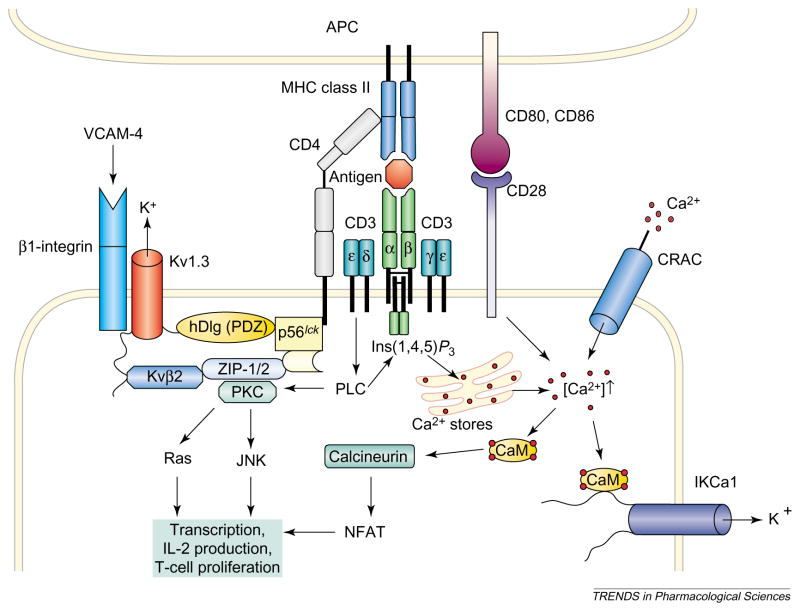Figure 2.
The involvement of voltage-dependent Kv1.3 channels, intermediate-conductance Ca2+ -activated IKCa1 channels and voltage-independent Ca2+ release-activated Ca2+ (CRAC) channels in the activation of a CD4+ T cells by an antigen-presenting cell (APC) is shown. Engagement of the T-cell receptor–CD3 complex through an antigenic peptide presented in the context of major histocompatibility complex (MHC) class II activates phospholipase C (PLC), which leads to the activation of protein kinase C (PKC) and the production of inositol (1,4,5)-trisphosphate [Ins(1,4,5) P3], which liberates Ca2+ from intracellular stores. Simultaneous activation of CD28 by the co-stimulatory molecules CD80 or CD86 further amplifies the resulting Ca2+ signal. The rise in the intracellular concentration of Ca2+ activates the phosphatase calcineurin, which then dephosphorylates the transcription factor nuclear factor of activated T cells (NFAT), enabling it to accumulate in the nucleus and bind to the promoter of the gene encoding interleukin 2 (IL-2). Parallel activation of the c-JUN N-terminal kinase (JNK) and Ras by PKC results in the activation of other transcription factors and initiates transcription of various genes and finally T-cell proliferation. CRAC, Kv1.3 and IKCa1 channels regulate Ca2+ signaling. Depletion of internal Ca2+ stores causes CRAC channels in the membrane to open, and the ensuing Ca2+ influx sustains elevated levels of cytosolic Ca2+. Ca2+ influx through CRAC channels is reduced following membrane depolarization. The driving force for Ca2+ entry is restored by membrane hyperpolarization brought about by the opening of Kv1.3 channels in response to membrane depolarization and the opening of IKCa1 channels as a consequence of elevated concentrations of cytosolic Ca2+. Selective blockade of K+ channels leads to membrane depolarization, inhibits Ca2+ influx and shuts down cytokine production and cell proliferation. Abbreviations: CaM, calmodulin; hDlg, human homolog of the Drosophila discs large tumor suppressor protein; VCAM-4, vascular cell adhesion molecule 4; ZIP-1, Zrt/Irt-like protein.

